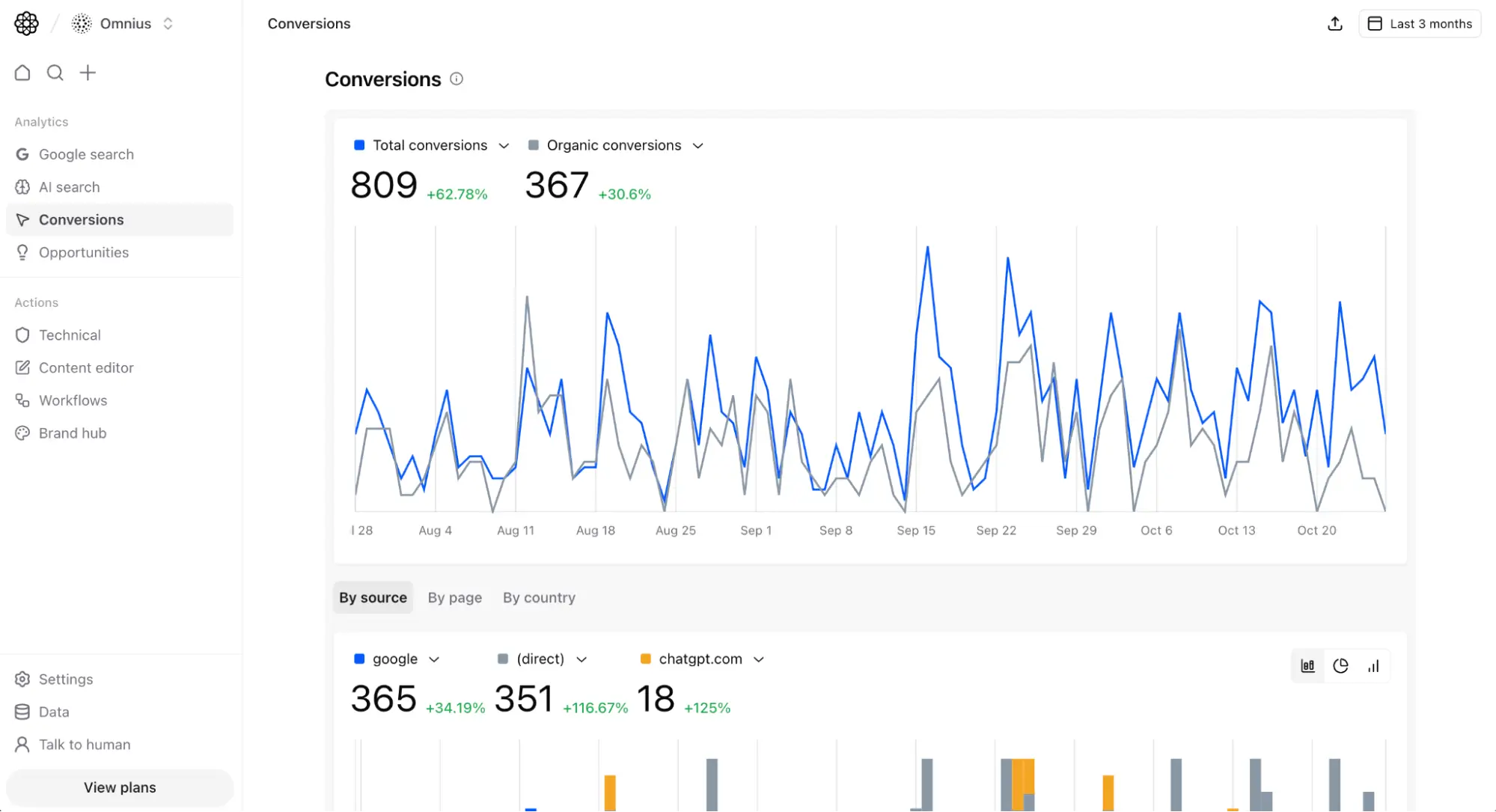






Conversion attribution in modern search ecosystems is no longer linear. Users interact with AI summaries, zero-click queries, and multiple channels before taking measurable actions. Atomic’s SEO Conversion Attribution module resolves this complexity by mapping user intent across traffic sources and linking those signals to validated conversion events.
The dashboard provides a unified view of conversion flow - showing how Google, Direct, and AI engines such as ChatGPT and Perplexity influence outcomes. By isolating these pathways, teams can identify which sources deliver qualified intent and which interactions require optimization to close attribution gaps.
Atomic’s attribution engine merges session-level analytics from GA4, search referrer data, and AI search detectors into a consolidated attribution graph. Each conversion event is processed through a three-layer system:
The outcome is a granular map of how search exposure translates into business metrics, bridging the gap between visibility and conversion intelligence.
The overview chart visualizes Total Conversions and Organic Conversions over time, helping teams track how organic demand scales relative to total activity. Below, segmented breakdowns reveal conversion performance by source, by page, and by country.
Each source row displays:
For example, Google may deliver 365 conversions (+33.21%) with a session average of 18 seconds, while ChatGPT shows smaller volume but higher relative growth (+87.5%), indicating emerging intent through AI referral traffic.
Atomic’s attribution methodology unifies multiple analytical layers:
Each data point undergoes normalization for duplicate sessions, referrer mismatches, and delayed goal completions. This ensures attribution precision and consistency across multiple user touchpoints.
Traditional attribution frameworks collapse when facing AI-mediated discovery. In 2025, a growing share of organic journeys begin in generative platforms or zero-click environments where analytics tracking is incomplete. Without intent-based attribution, teams cannot distinguish between high-intent visits and passive exposure.
Atomic’s Intent Mapping system closes this blind spot by correlating AI search visibility with measurable engagement. It allows teams to quantify:
This insight drives budget alignment, content prioritization, and optimization of organic funnels.
Each conversion carries contextual metadata:
Tracking intent patterns allows analysts to distinguish between awareness-stage interactions and purchase-driven actions. For instance, ChatGPT traffic may demonstrate high engagement but moderate conversion rates - signaling strong informational intent but weaker transactional depth.
Teams use SEO Conversion Attribution to:
For example, a B2B SaaS brand may find that informational articles attract ChatGPT-originated sessions with high dwell time but low conversion ratio, while direct navigational visits from branded queries convert faster. These insights guide resource allocation toward content that both attracts and converts.
The attribution module integrates directly with:
Together, these components create a continuous feedback loop between visibility analytics and conversion intelligence, ensuring that every organic improvement is traceable to its business impact.
Attribution is no longer about counting conversions - it’s about understanding intent pathways. Atomic enables growth and SEO teams to pinpoint which interactions generate measurable value and which simply build exposure. By combining organic, AI, and direct channel insights, Atomic transforms fragmented analytics into a unified conversion narrative.

Atomic uses time-decay and interaction-weighted modeling. Credit is distributed proportionally to each verified source contributing to a conversion path.
Yes. Atomic captures conversions from verified AI engine referrals such as ChatGPT, Perplexity, and Gemini where referrer and session evidence exist.
Data refreshes daily, combining the latest GA4 events with Atomic’s AI detection logs to ensure up-to-date attribution.
Intent mapping classifies conversions by user intent type (informational, commercial, navigational, transactional) to identify which search behaviors drive measurable outcomes.
Yes. The module includes views for By Page and By Country, allowing segmentation of conversion performance across key dimensions.
Emerging AI traffic often starts with lower volume but increases rapidly as visibility expands. Growth percentage reflects velocity rather than total scale.
Yes. Atomic’s attribution engine connects to GA4, CRM systems, and reporting APIs for unified conversion tracking.


Integrate your data sources with Atomic in as little as 5 minutes.

Integrate with Atomic, and get up & running in 5 minutes.

Your data is visible only to you. Our system is completely encrypted.